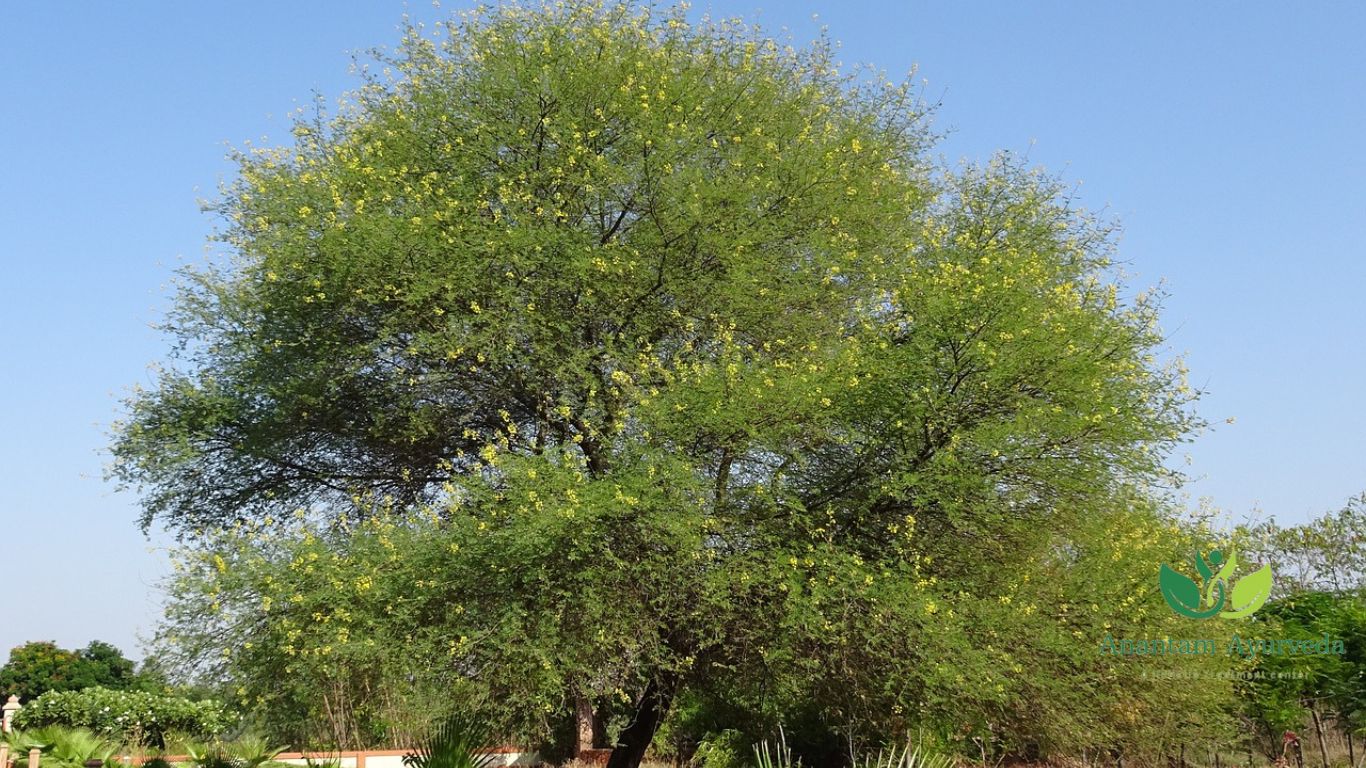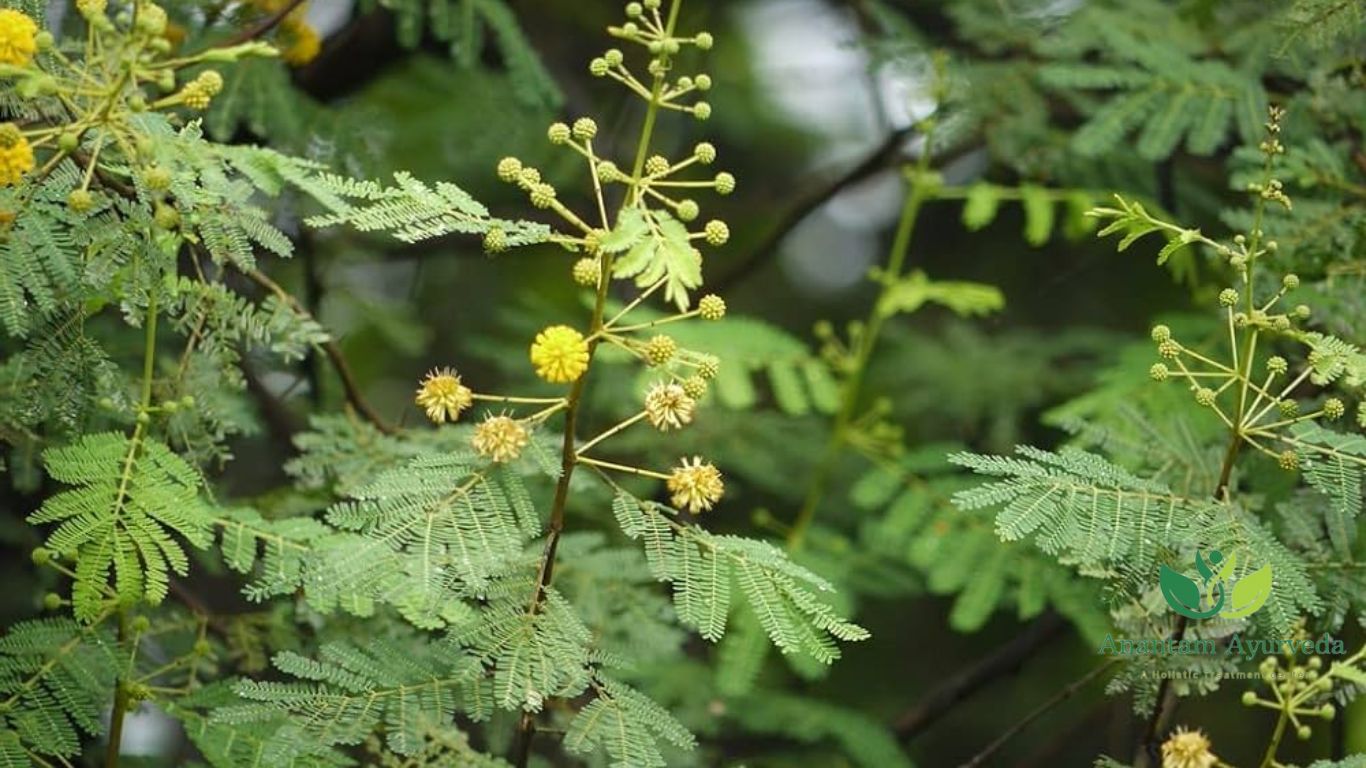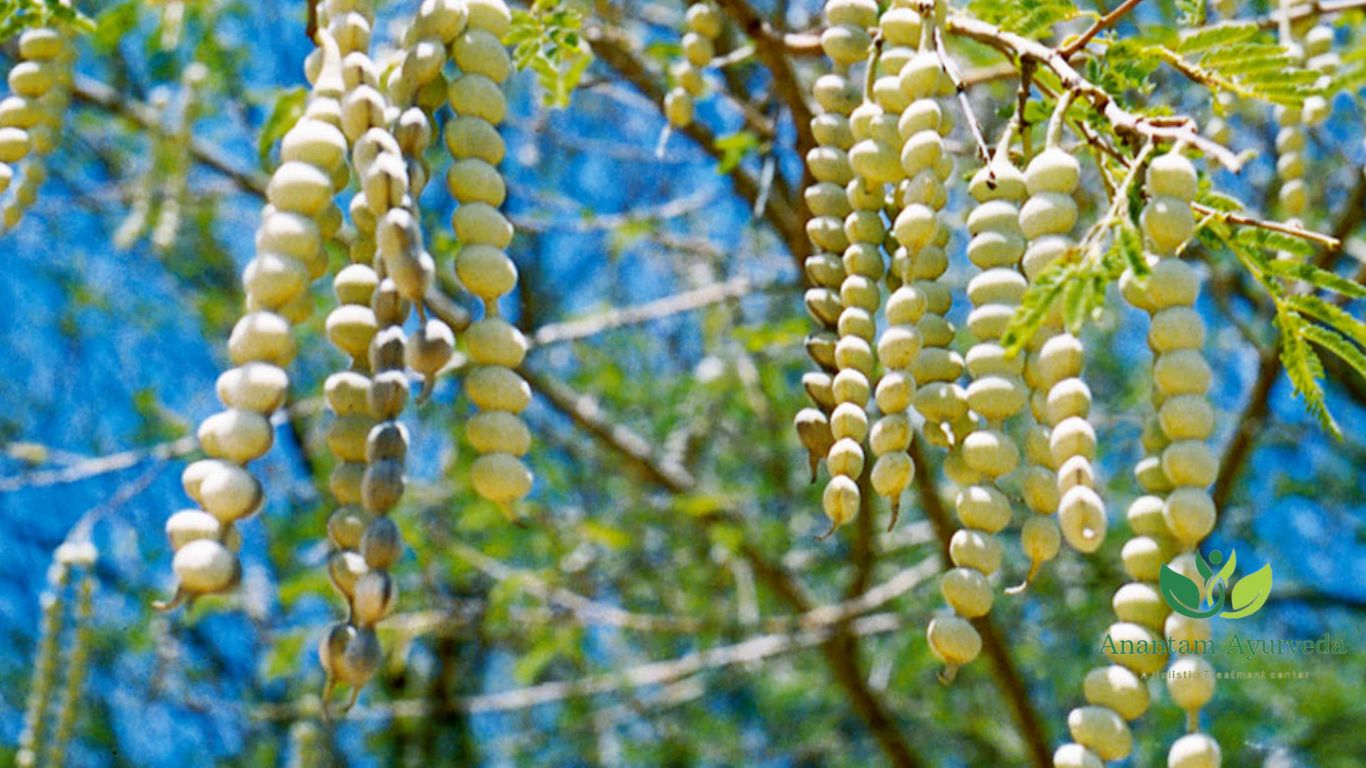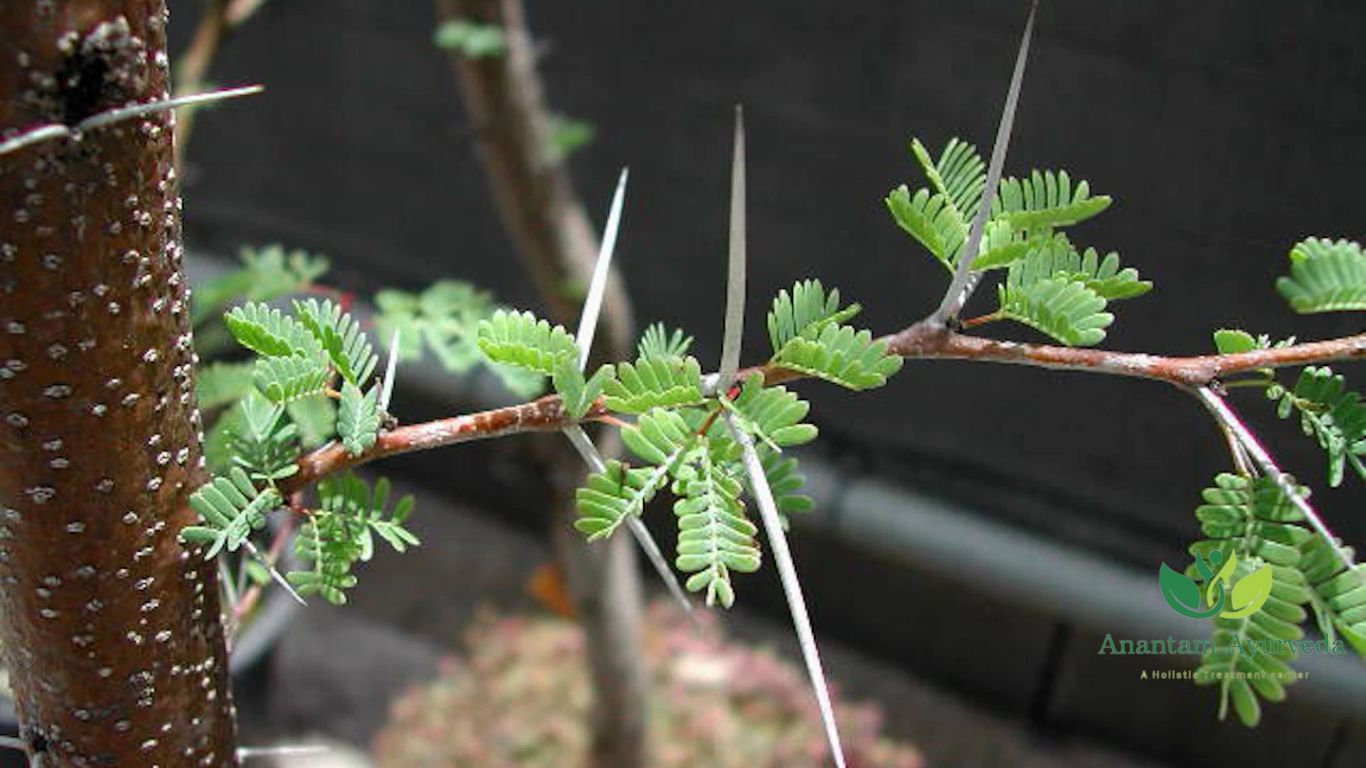Babool (Vachellia nilotica): Babool Tree Benefits
Introduction to Babool (Vachellia nilotica)
Babool, scientifically known as Vachellia nilotica, is a remarkable medicinal tree that has been extensively used in Ayurveda for centuries. It is commonly found in India, Africa, and parts of Asia, where it thrives in dry and arid conditions. Known for its multiple therapeutic properties, it has gained recognition in herbal medicine and traditional healing systems. From oral health to digestive well-being, it offers a wide range of health benefits that make it a staple in Ayurvedic medicine.

Taxonomical Classification
- Kingdom – Plantae
- Division – Magnoliophyta
- Class – Magnoliopsida
- Family – Fabaceae (Leguminosae)
- Genus – Acacia
- Species – A. arabica, A. nilotica
Vernacular Names
Names in Different Languages
- English – Babool, Indian Gum Arabic Tree
- Hindi – Babool, Keekar
- Bengali – Baabla
- Kannada – Jaali Mara
- Tamil – Karuvel
- Telugu – Nallatumma
Sanskrit Synonyms
- Yugmakanta – Two spikes are seen together
- Dridaruha – The stem and branches of the plant are strong
- Sookshma Patra – The leaves are small in appearance
- Malaphala – The fruit pods resemble a chain
- Kantaki – Has spikes
- Sapeetaka, Peetapushpa – Yellow flowers
- Kashayakaha – Natural astringent
- Kinkirata
- Aabha – Tree will have attractive yellow flowers during the flowering season
Classical Categorization and Habitat
- Kaiyyadeva Nighantu – Oushadhi Varga
- Shodala Nighantu – Amradi Varga
- Bhava Prakasha – Vatadi Varga
Varieties
According to Raj Nighantu Babool has two main varieties:
- Babool
- Jala Babool
Habitat
It is a small tree growing to a height of 8-10 meters, with small spikes. It is commonly found in the dry regions across India. The Babool plant is highly demanding of sunlight but sensitive to cold. It is widely distributed in arid and semi-arid regions of the world. The rainfall requirement ranges from 100mm to 1000mm. Due to its long tap root system (Phreatophyte), it can scavenge water from deeper soil layers. It can tolerate salinity and grows in shallow and rocky areas.

Morphology
It is a perennial shrub or small tree that can grow up to 20 meters tall. Its branches spread, forming a crown shape with a dark brown to black-colored stem. The bark is thin, rough, fissured, and reddish-brown. The thorns are thin, erect, and light grey, while mature trees are spineless. The flowers are bright yellow, small, clustered as round heads, and have a sweet fragrance. The fruit pods are linear-oblong in shape, glaucous-green in color, and covered with minute hairs. The seeds are dark brown, and brownish-white gum exudes from the trunk.
Bioactive Compounds
The tree contains a variety of bioactive compounds, including:
- Tannins
- Flavonoids
- Saponins
- Glycosides
- Alkaloids
It contains 12-20% tannins along with essential flavonoids like Kaempferol-3-glucoside, Iso-quercitrin, and Leucocyanidin. The gum resin consists of galactose, aldobio uronic acid, and arabinobioses, with high amounts of calcium (52%) and magnesium (20%)
These compounds contribute to Babool’s antimicrobial, anti-inflammatory, and astringent properties, making it a valuable herb in Ayurvedic formulations.

Medicinal Properties of Babool According to Bioactive Compounds of Different Plant Part
| Plant Part | Phytochemicals | Medicinal Properties |
|---|---|---|
| Leaves | Tannins, Proteins, Saponins, Glycosides, Triterpenoids, Flavonoids, Phenol, β-Sitosterol, D-Pinitol | Anti-Diabetic, Anti-Cancer, Anti-Hypertensive, Anti-Diarrheal, Anthelmintic |
| Bark | Carbohydrates, Anthraquinone, Methyl Gallate, Gallic Acid, Umbelliferone, Diterpene, Niloticane, Cassane | Antibacterial, Anti-Diabetic, Anti-Thrombotic, Anti-Inflammatory, Anti-Carcinogenic, Antioxidant, Diuretic, Anti-Molluscicidal |
| Gum | Tannin, Terpenoids, Polysaccharides, Calcium, Magnesium, Potassium | Antipyretic, Anti-Asthmatic, Anti-Ulcerative, Anti-Diabetic, Immuno-Modulatory, Anti-Malarial, Protective Effect on Reproductive Organs |
| Flowers | Naringenin, Acetylcholine, Gallic Acid, Glucopyranoside, Kaempferol | Antioxidant, Astringent, Immuno-Modulatory, Treating Leucorrhea |
Properties, Parts Used, and Dosage
Medicinal Properties of Babool (Acacia arabica)
- Rasa (Taste): Kashaya (Astringent)
- Guna (Qualities): Guru (Heavy to digest), Rooksha (Dry in nature)
- Veerya (Potency): Sheeta (Coolant)
- Vipaka (Post-digestive effect): Katu (Undergoes pungent taste conversion after digestion)
- Karma (Action): Kapha Hara (Balances Kapha Dosha)
- Pharmacological Action: Astringent, Analgesic, Styptic
Parts Used
- Stem Bark
- Fruit
- Gum
- Seeds
The Niryasa (Gum Resin) is Pitta-Vatahara (reduces Pitta and Vata dosha) and helps in reducing uterine swelling. The stem bark and pods act against intestinal worms and aid in blood coagulation.
Recommended Dosage
- Decoction: 20-30 g for preparation, 50 – 100 ml per day (in divided doses)
- Seed Powder: 3-6 g per day
- Acacia Gum: 2 – 3 g per day

Traditional Ayurvedic Uses of Babool
1. Oral Health and Dental Care
One of the most well-known benefits of Babool is its effectiveness in maintaining oral hygiene. Ayurvedic practitioners recommend using Babool twigs as a natural toothbrush, known as Datun, for its antibacterial properties. It helps in:
- Preventing cavities and plaque formation
- Strengthening gums and reducing gum inflammation
- Eliminating bad breath
- Healing mouth ulcers
The tannins present in Babool bark provide astringent effects, which help tighten the gums and prevent gum recession.
2. Digestive Health Benefits
It has a significant impact on digestive wellness, as it is rich in fiber and anti-inflammatory agents. It helps in:
- Managing diarrhea and dysentery due to its astringent properties
- Soothing gastric ulcers and reducing acidity
- Aiding in proper digestion and preventing constipation
Babool bark is often used in Ayurvedic decoctions to help with gastrointestinal disorders and intestinal infections.
3. Respiratory Support
It is a potent expectorant and is widely used in Ayurveda to treat respiratory disorders like asthma, bronchitis, and cough. The antimicrobial and anti-inflammatory properties help in:
- Clearing mucus from airways
- Reducing inflammation in the lungs
- Relieving symptoms of chronic cough and bronchitis
Babool bark and leaves are often included in Ayurvedic herbal teas and decoctions for respiratory relief.
4. Wound Healing and Skin Care
It has excellent antiseptic and wound-healing properties. It is used in traditional medicine to:
- Heal cuts, burns, and wounds effectively
- Treat skin infections such as eczema and rashes
- Reduce acne and blemishes due to its antibacterial action
Babool gum and bark extracts are often included in herbal ointments to promote faster recovery of wounds and prevent infections.
5. Bone and Joint Health
In Ayurveda, it is known for strengthening bones and joints. It is commonly used to:
- Reduce symptoms of arthritis and joint pain
- Enhance calcium absorption in bones
- Alleviate swelling and inflammation in joints
Babool gum is often included in Ayurvedic formulations to improve bone density and manage osteoporosis.
Ayurvedic Formulations of Babool
1. Dasanakanti Churnam
An herbal tooth powder that strengthens gums and teeth, prevents plaque, and fights oral infections.
2. Trayodashang Guggulu
A tablet formulation that alleviates joint pain, arthritis, and sciatica with its anti-inflammatory properties.
3. Pepcer Capsule
A digestive health formulation that soothes gastric ulcers, gastritis, and acidity.
4. Khadiradi Gutika
A tablet used for throat infections and cough. Babool bark acts as a natural binding agent, enhancing its effectiveness.
5. Babularishta
A herbal tonic that relieves respiratory issues like cough, cold, and congestion.
6. Babool Bark Powder
Used for oral hygiene when applied externally and for gut health when ingested.

How to Use Babool
1. Babool Twigs (Datun)
How to Use:
- Select a fresh Babool twig and peel off the outer bark.
- Chew one end until it forms natural bristles, then use it as a toothbrush.
- Spit out the residue after brushing.
Benefits:
- Strengthens gums and teeth
- Prevents cavities, plaque, and bad breath
- Heals bleeding gums and mouth ulcers
2. Babool Bark Decoction
How to Use:
- Boil 2 teaspoons of Babool bark powder in 1 cup of water for 10–15 minutes.
- Strain and drink warm.
- Consume twice daily for best results.
Benefits:
- Treats diarrhea, dysentery, and indigestion
- Soothes gastric ulcers and acidity
- Purifies the blood
3. Babool Gum Powder
How to Use:
- Mix ½ teaspoon of Babool gum powder with warm water or milk.
- Take once or twice daily.
Benefits:
- Relieves joint pain and arthritis
- Strengthens bones and enhances calcium absorption
- Reduces skin inflammation
4. Babool Bark Powder for Wound Healing
How to Use:
- Mix bark powder with rose water or honey to form a paste.
- Apply to cuts, wounds, burns, or acne-prone skin.
- Leave for 15–20 minutes, then rinse with warm water.
Benefits:
- Accelerates wound healing and prevents infection
- Reduces acne, blemishes, and skin rashes
- Soothes burns and skin irritation
5. Babool Flower Infusion for Respiratory Health
How to Use:
- Boil 1 teaspoon of dried Babool flowers in 1 cup of water for 5–7 minutes.
- Strain and drink warm, once or twice daily.
Benefits:
- Treats cough, asthma, and bronchitis
- Acts as a natural expectorant to clear mucus
- Boosts immunity and respiratory function
6. Babool Resin with Honey for Cough Relief
How to Use:
- Mix ¼ teaspoon of Babool resin powder with 1 teaspoon of honey.
- Take twice daily to ease congestion.
Benefits:
- Clears mucus buildup in the lungs
- Relieves sore throat and dry cough
- Provides soothing relief from respiratory infections
7. Leaf Powder for Blood Sugar Control
How to Use:
- Take ½ teaspoon of Babool leaf powder with warm water every morning.
Benefits:
- Regulates blood sugar levels
- Supports insulin function and metabolism
- Prevents sudden sugar spikes
8. Powder with Milk for Women’s Health
How to Use:
- Mix 1 teaspoon of Babool bark powder with warm milk.
- Drink at bedtime for maximum benefits.
Benefits:
- Supports post-pregnancy recovery
- Promotes uterine health
- Treats leucorrhea (excess vaginal discharge)
Scientific Studies Supporting Babool’s Benefits
Several scientific studies have validated the traditional use of Babool in Ayurvedic medicine:
- A study published in the Journal of Ethnopharmacology highlighted Babool’s antimicrobial properties in oral health management.
- Research in the International Journal of Pharmaceutical Sciences demonstrated its effectiveness in treating diarrhea and gut infections.
- Clinical trials on Babool gum showed promising results in bone health enhancement and arthritis management.
Precautions and Side Effects
While it is generally safe, certain precautions should be taken:
- Excessive consumption may cause constipation
- Pregnant and lactating women should consult an Ayurvedic practitioner before use
- People with hypoglycemia should use it with caution, as it may lower blood sugar levels
Conclusion
Vachellia nilotica is a powerful medicinal tree that holds immense value in Ayurveda. From oral hygiene to digestive and respiratory health, Babool provides numerous therapeutic benefits. Its antimicrobial, anti-inflammatory, and wound-healing properties make it an essential herb in natural medicine. Incorporating Babool into daily health routines can promote overall wellness and prevent various ailments.

FAQs About Babool (Vachellia nilotica)
1. What Is Babool?
Babool, also known as Vachellia nilotica, is a thorny tree celebrated for its medicinal benefits in Ayurveda. It supports oral health, digestion, and overall well-being.
2. How Does it Improve Oral Health?
Chewing fresh Babool bark strengthens gums and teeth due to its astringent properties. It helps prevent cavities, reduces plaque buildup, and soothes gum inflammation.
3. Can Babool Help Manage Diarrhea?
Yes, Babool bark’s astringent properties regulate intestinal movements, improve metabolism, and strengthen the digestive system, making it effective for controlling diarrhea.
4. Is it Effective for Cough and Cold?
Babool bark balances the Kapha dosha, helping to expel mucus from the respiratory tract. This provides relief from coughs, colds, and breathing difficulties.
5. Does it Assist in Wound Healing?
Applying a paste made from Babool leaves or bark speeds up wound healing. Its antibacterial properties control bleeding, prevent infections, and promote tissue regeneration.
6. Can Babool Support Diabetic Management?
Babool shows potential in managing blood sugar levels. However, consult a healthcare provider before using Babool as part of a diabetes treatment plan.
7. What Precautions Should I Take When Using it?
Excessive Babool intake can cause hyperacidity. Pregnant and breastfeeding women should avoid it. Always seek medical advice before adding Babool to your routine.
8. How Does it Enhance Sexual Wellness?
Babool fruit pods are known for their aphrodisiac properties. They may boost libido in both men and women and help with issues like premature ejaculation.
9. Is it Good for Skin Health?
It’s antimicrobial and soothing properties make it effective for treating wounds, acne, and skin infections. Applying a paste of Babool bark or leaves promotes skin healing and reduces inflammation.
10. Can Babool Be Used for Hair Care?
It is believed to strengthen hair, reduce dandruff, and improve scalp health. While promising, more scientific research is needed to confirm these benefits.
11. How Should I Consume it for Health Benefits?
It can be taken as powder, decoction, or in herbal formulations. Babool bark powder with warm water or honey is common. Follow recommended dosages and consult a doctor.
12. Are There Any Side Effects of it?
Excessive use may cause digestive issues like nausea, bloating, or diarrhea. Rarely, it may trigger conjunctivitis. Use Babool in moderation and under medical supervision.
13. Who Should Avoid it?
People allergic to Babool or other Acacia species should avoid it. Pregnant or breastfeeding women, and individuals with specific health conditions, should consult a doctor first.
14. Can Babool Treat Leucorrhea?
Chewing Babool leaves and drinking water in the morning has been traditionally used to manage vaginal discharge due to its cooling and astringent effects.
15. Is it Helpful in Managing Teeth Disorders?
Yes, it is considered one of the best Ayurvedic herbs for maintaining oral health. Regular use helps strengthen gums and teeth, reducing plaque formation and gingival inflammation.
16. Can Babool Help in Managing Diabetes?
It possesses properties that may help in managing blood sugar levels. However, it’s essential to consult a healthcare professional before using it as a treatment for diabetes.
17. How Can Babool Be Used for Sexual Wellness?
The fruit pods of it have aphrodisiac properties and are used in Ayurveda to enhance libido in both men and women. They may also be effective in addressing issues like premature ejaculation in men.
18. Is it Beneficial for Skin Health?
Yes, Babool’s antimicrobial and soothing properties can aid in treating wounds, acne, and skin infections. Applying a paste of Babool bark or leaves may promote skin healing and reduce inflammation.
19. Can Babool Be Used for Hair Care?
It is believed to strengthen hair, reduce dandruff, and promote scalp health. However, more research may be needed to substantiate these claims.
You can also read about Vidarikand (Pueraria tuberosa): Vidarikand Benefits for Males
